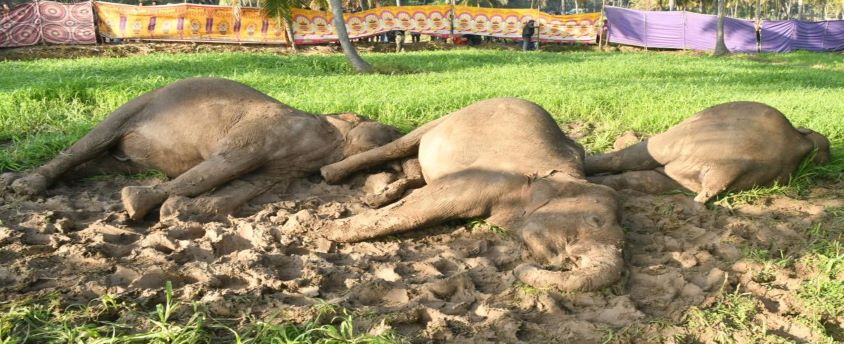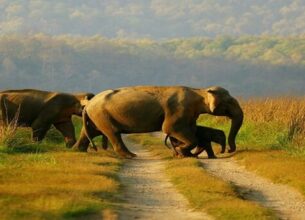Man and Elephant Conflicts
08, Mar 2023

Prelims level : Bio Diversity & Its Threat
Mains level : GS-III Conservation, environmental pollution and degradation, environmental impact assessment.
Why in News?
- Two adult female elephants and a makhna were electrocuted by an illegal electric farm fence here, near a village in Marandahalli recently.
What does the report say?
- A document accessed from the Ministry through the Right to Information (RTI) Act revealed that While electrocution claimed the lives of 741 elephants, train hits led to the death of 186 pachyderms, followed by poaching – 169, and poisoning – 64.
- Karnataka and Odisha lost 133 elephants each due to electrocution during the period and Assam reported 129 deaths.
- Among elephant casualties due to train hits, Assam stood first with 62 deaths, followed by West Bengal at 57.
- A total of 169 mammals were killed by poachers in the 10 years and Odisha reported the highest – 49 deaths, followed by Kerala 23.
- Assam reported the highest number of elephants poisoned – 32, and Odisha stood second with 15 deaths.
What are the Government efforts in Project Elephant?
- The document said financial and technical assistance were provided to elephant range States under the Centrally sponsored ‘Project Elephant’ scheme to protect elephants, their habitat and corridors to address issues of man-elephant conflict and welfare of captive elephants.
- The Ministry released ₹5 crore under the Project Elephant to 22 States in the 10 years.
- Among various measures taken, the document said that guidelines for the management of human-elephant conflict had been issued by the Ministry in October 2017 and elephant range States had been requested to implement the same.
- Critical elephant habitats are notified as ‘elephant reserve’ for focus and synergy in elephant conservation and to reduce conflict. A total of 30 elephant reserves have been established in 14 major elephant States.
- To reduce man-elephant conflict and to avoid retaliatory killing of elephants, compensation is provided to local communities for loss of property and life caused by wild elephants.
- A Permanent Coordination Committee has been constituted between the Ministry of Railways and the MoEFCC for preventing elephant deaths due to train hits.
What is the concern?
- Few regions like Gudalur in Tamil Nadu has been in the centre of the human-elephant conflict for the past few decades with research studies indicating that the disappearance of forest cover and swamp lands, and the associated micro habitats, had led to this trend.
- The death of humans, more males than females, after attacked by the wild elephants and the number of deaths of elephants caused by human beings has also been high in these range in the past few decades.
- Likewise, the property damaged by elephants has also been high in the range.
What is Human-Elephant Conflict?
- Human-Elephant Conflict is broadly defined as “any human-elephant interaction that brings negative effects on social, economic or cultural life of humans, on elephant conservation or on the environment”.
- Human-Elephant Conflict can be categorised as ‘direct’ or ‘indirect’.
- Direct Conflicts: Direct conflicts impacts upon economic and physical well being of the rural communities. Examples of direct conflict are crop damage, human death and Injury, damage to food stores, damage to other properties.
- Indirect Conflicts: Indirect conflicts results in indirect social impacts upon people. For example, the efforts put on by the farmers to their crops and property, the fear of injury or death, and psychological stress etc. However unlike the direct conflicts, the impact of indirect conflicts cannot be translated to economic value.
Why Human-Elephant conflicts occur?
- Unlike tigers whose territories are within the protected areas, the elephants have only 20% of their range falling in the protected areas like national parks and sanctuaries. There are about 28 elephant reserves across India covering 61,830 sq. km.
- Due to deforestation and thinning out of forests, the elephants tend to disperse into areas with high density of human population.
- This has made the elephants to foray into areas where they had no history of presence for several decades, even centuries. Destruction of elephant habitat has made them to move constantly.
- Second, the growing human population has resulted in the expansion of human settlements in the elephant migration routes.
- This often results in the human-elephant conflicts. As of now, there are approximately 100 elephant corridors in the country.
- The conflict gets intensified when people try to chase away elephants with searchlights, crackers or guns, making the elephants even more aggressive.
Key Facts regarding the Conflicts:
- Between 2015 and 2020, nearly 2,500 people have lost their lives in elephant attacks across India out of which about 170 human fatalities have been reported in Karnataka alone, according to KVIC.
- India has the largest number of wild Asian Elephants, estimated at 29,964 according to the 2017 census by Project Elephant. The figure amounts to about 60% of the species’ global population.
- Over 500 humans are killed in encounters with elephants annually, and crops and property worth millions are also damaged. Many elephants are also killed in retaliation due to conflict.
Other practices to ward of Elephants:
- A pilot project launched in Kodagu entails installing bee boxes along the periphery of the forest and the villages with the belief that the elephants will not venture anywhere close to the bees and thus avoid transgressing into human landscape. This idea stems from the elephants’ proven fear of the bees.
- A variety of management strategies and practices has been developed and customised for implementing at different scales by the State Forest Departments for preventing and mitigating human-elephant conflict.
- These best practices have been discussed under several categories such as retaining elephants in their natural habitats by creating water sources and management of forest fires.
- The other best practices include elephant-proof trenches in Tamil Nadu, hanging fences and rubble walls in Karnataka, use of chilli smoke in north Bengal and playing the sound of bees or carnivores in Assam.
Use of technology in avoiding conflicts:
- The process of individual identification and monitoring of elephants in south Bengal. Other ideas include sending SMS alerts to warn of elephant presence.
- The elephant expert recommended cost-benefit analysis for these policies and said that it should be done in context of the economic damage caused by elephants to crops.
- Practices such as elephant-proof trenches should be discouraged in areas that receive more than 1,500 mm rainfall a year. “Hanging wire electric fences that produce electricity for milliseconds have given positive results. These practices have been tried in Sri Lanka and Tamil Nadu”.
Innovative practices around the world to minimise Human-Elephant conflicts:
- To keep elephants at a safe distance from their farms and homes, some African villagers have turned to two unlikely, all-natural solutions: bees and hot peppers. Elephants dislike the chemical capsaicin found in chilli peppers, prompting farmers in Tanzania to smother their fences with a mixture of oil and chilli peppers.
- Solar powered electric fences keep crop-raiding elephants out of fields in Africa.
- In Canada, they constructed wildlife corridors, areas of preserved native habitat in human dominated regions, providing wildlife with a safe pathway as they travel between one to another.
About Asian Elephants:
- There are three subspecies of Asian elephant – the Indian, Sumatran and Sri Lankan.
- The Indian has the widest range and accounts for the majority of the remaining elephants on the continent.
- African elephants are listed as “vulnerable” and Asian elephants as “endangered” in IUCN Red List of threatened species.
- The elephant has been accorded the highest possible protection under the Indian wildlife law through its listing under Schedule I of the Wildlife (Protection) Act, 1972.
- Government of India has launched various initiatives for conservation of elephants.
What is Project Elephant?
- Project elephant is a centrally sponsored scheme launched in February 1992. The scheme helps and assists in the management and protection of elephants to the States having free-ranging populations of wild elephants, in order to ensure the survival of elephant population in the wild and protection of elephant habitat and elephant corridor.
- Project elephant is mainly implemented in 16 States / UTs, which includes Andhra Pradesh, Arunachal Pradesh, Assam, Jharkhand, Kerala, Nagaland, Meghalaya, Karnataka, Tamil Nadu, Uttar Pradesh, Orissa, Uttaranchal West Bengal Maharashtra and Chhattisgarh.
- The union government provides financial and technical assistance to the states to achieve the goals of this project. Help is also provided for the purpose of the census, training of field officials and to ensure the mitigation and prevention of human-elephant conflict.
- There are around 32 elephant Reserves in India notified by the state governments. The first elephant reserve was the Singhbhum elephant Reserve of Jharkhand.
What are its other Conservation Efforts?
- ‘Gaj Yatra’ a nationwide awareness campaign to celebrate elephants and highlight the necessity of securing elephant corridors.
- The Wildlife Trust of India (WTI), had come out with a publication on the right of passage in 101 elephant corridors of the country in 2017, stressed on the need for greater surveillance and protection of elephant corridors.The Monitoring the Killing of Elephants (MIKE) programme launched in 2003 is an international collaboration that tracks trends in information related to the illegal killing of elephants from across Africa and Asia, to monitor effectiveness of field conservation efforts.







